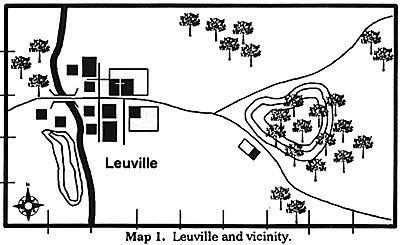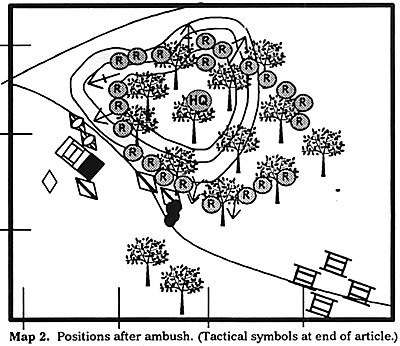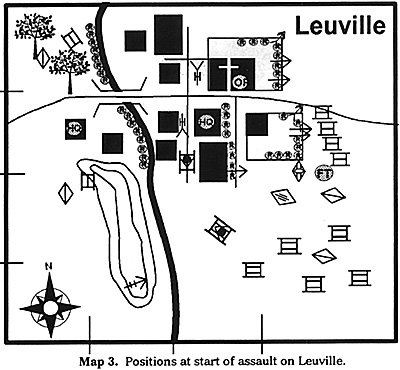"The Defense of Leuville" scenario was designed for balance and lots of action. Intended to portray one of the desperate road block actions in the early days of the Battle of the Bulge, "The Defense of Leuville" pits an American force of high quality infantry, but poor armor, against the advanced guard of a Panzer Division. The focus for both sides is the same: the bridge at Leuville.
The American force is built around an elite Airborne Infantry Company and the remnants of a green armored unit. The American armored unit is holding Leuville after having been mauled in a fight for another village earlier in the evening. The Paratroopers arrive to reinforce the armored troops and prepare a defense of the village. There is not much time to dig in before dawn. Another challenge for the Americans is that the Germans can enter the map from one of two roads, forcing the American players to orient their defense in two directions.
The German players are the advanced guard of the 116th Panzer Division. With spirits high from the victory over the green American armor, the panzer unit is getting ready to advance on Leuville at first light. The German commander must decide which road to use. Each has advantages and disadvantages. The northern road offers more open terrain for maneuver of the German vehicles, but also offers less cover. The southern road has more concealment, but also will allow the Americans more opportunity to ambush the Germans in the close terrain.
THE COURSE OF THE GAME
We began at about 10 AM. There were three players on each side. From the attached situations you can see the forces an information that was provided to each side. While the Germans got their units assembled and analyzed the map (they were specifically NOT given the opportunity to study the terrain board, thus having to use the map to decide which road to enter from), the Americans plotted their defense. It was a challenge.
 The American commander realized that he could not hope to stop the Germans in the relatively open area east of Leuville. But he did need to do something to slow them down. Therefore, one infantry platoon, a bazooka team, and one M4A3 Sherman were posted around the wooded hill and farm on the southern road. The American plan was to strip away the German infantry before it could get into the town where the decisive battle for the bridge would take place. The gamble was that the Germans would come along the southern road (Map 1).
The American commander realized that he could not hope to stop the Germans in the relatively open area east of Leuville. But he did need to do something to slow them down. Therefore, one infantry platoon, a bazooka team, and one M4A3 Sherman were posted around the wooded hill and farm on the southern road. The American plan was to strip away the German infantry before it could get into the town where the decisive battle for the bridge would take place. The gamble was that the Germans would come along the southern road (Map 1).
In the town itself another infantry platoon was dug in along the forward edge of the village. An observer for the 60 mm mortars was posted in the church steeple, and the remaining armor placed in the western portion of the village as a counterattack reserve.
The 57 mm AT guns were positioned inside the town, facing into the main street. The Germans entered the map on the southern route, with their recon section in the lead. For two turns nothing happened, until the Germans pulled off the road near the farm--at that point the fight started.
When the lead German armored car-traveling on the roadcame around the edge of the farm, it was fired at by the Sherman waiting in the farm yard. Careening to a halt from a hit in the hull, the uninjured German crew bailed out of the vehicle. Meanwhile, the heavily armed German SdKf:z 250 was sneaking up on the Sherman from the rear.
As the Sherman tried to finish off the armored car, it was hit in the turret rear by the 250's 37 mm gun. A BOUNCE The little shell could not penetrate. The Sherman ominously turned its turret in the halftrack's direction--only to take a panzerfaust on the turret face, courtesy of the now dismounted panzergrenadiers. As a result of the panzerfaust penetration, even though the tank was not damaged, the crew panicked and bailed out into the farm yard. No rest for the panzergrenadiers, however, as they are now under fire from long-range .50 cal MG fire coming from the hill top on the west side of the river. The gunner of the halftrack's 37 goes down.
As this fight for the farm is underway, the main body of the Kampfgruppe is rumbling up the road. Seeing the gunfire ahead of them, the Germans are cautious. Panthers are covering the advance from halted positions as the panzergrenadier platoon heads up the road to the farm.
As the panzergrenadier platoon reaches the farm, the men begin to dismount. One squad has pulled off the road beside the farm house; two other rifle squads squeal to a halt across the road directly beside the woods. Suddenly--without warning--rifle and submachine gun fire, bazooka shots, and grenades pour from the woods toward the two halftracks. The effect is devastating.
The first three men of the lead halftrack are gunned down as they get out the back of the vehicle. Then a grenade goes into the troop compartment of their vehicle-BOOM!!! The rest of the squad is wiped out. Disaster also befalls the second halftrack. Before any man can dismount, the machine gunner is cut down by the fire of an American Thompson, and then a bazooka round smacks into the vehicle.
 A thunderous blast shakes the scene as the second halftrack erupts in a fireball-no one escapes the blast. The Panther on overwatch back down the road cuts loose with a 75 mm HE round, wiping out the bazooka team. Having accomplished their ambush mission, the rest of the American squad retreats back into the depths of the woods. Two of the three German rifle squads have been wiped out to a man (Map 2).
A thunderous blast shakes the scene as the second halftrack erupts in a fireball-no one escapes the blast. The Panther on overwatch back down the road cuts loose with a 75 mm HE round, wiping out the bazooka team. Having accomplished their ambush mission, the rest of the American squad retreats back into the depths of the woods. Two of the three German rifle squads have been wiped out to a man (Map 2).
More Germans
The rest of the German force is still entering the map. Mark IVs, Flak vehicles, more Panthers, and engineers are piling into the game. Realizing they cannot get bogged down in a fight for the wooded hill, the Germans correctly elect to by-pass the hill and move in force toward Leuville. The Germans realize, however, that the loss of two rifle squads may have decisive effect in the upcoming battle for the bridge.
The Germans sweep past the farm and deploy the Mark IV platoon heading for the main road into town, while the Panther platoon moves toward the south side of the town. Both flak vehicles and the 81 mm mortar are posted to prevent the Americans in the wooded hill from moving against the rear of the force advancing on the town.
Waiting for the Germans in the hedges and fences on the eastern end of the town are two squads of Paratroopers, reinforced with bazookas and machine guns. As the Germans approach, the short range 60 mm mortars begin to drop among the German vehicles. Keeping their cool, the paratroopers wait for the Mark IVs to actually roll through the hedge and then open fire on them and the German engineer who are dismounting from their halftrack (Map 3).
 The lead Mark IV takes a bazooka hit on the hull flank as it rolls through the hedge. The tank's ammo goes up in a blast that kills the entire crew. Three of the German engineers also go down to rifle, submachine guns, and mortars. But the paratroopers come under return fire from the surviving German armored car that has accompanied the Mark IVs. Another Mark IV attempts to overrun foxholes, but catches a bazooka in the turret face, causing the vehicle to rumble past the line of foxholes. Incredibly, the vehicle is virtually undamaged and the crew keeps their composure and stays in the tank.
The lead Mark IV takes a bazooka hit on the hull flank as it rolls through the hedge. The tank's ammo goes up in a blast that kills the entire crew. Three of the German engineers also go down to rifle, submachine guns, and mortars. But the paratroopers come under return fire from the surviving German armored car that has accompanied the Mark IVs. Another Mark IV attempts to overrun foxholes, but catches a bazooka in the turret face, causing the vehicle to rumble past the line of foxholes. Incredibly, the vehicle is virtually undamaged and the crew keeps their composure and stays in the tank.
A third Mark IV kills a paratrooper in a foxhole with its hull MG, but then has its drive sprocket blown off by one of the 57 mm guns in the town. An alert Panther on the southern edge of the village spots the anti-tank gun and engages the American weapon in a duel. It is no contest. The little 57 scores three hits on the hull and turret front of the Panther, but all three shots bounce off. The veteran German tank crew puts an HE round right on the 57's gun shield, wrecking the weapon and killing the entire crew.
By now the gallant paratroop squad along the hedge has been destroyedmachine gunned or literally crushed in their foxholes by the two remaining Mark IVs. The Germans in the area are, however, still suffering. The already battered engineer squad hits the dirt as a 60 mm mortar round enters their vehicle, setting off half a dozen satchel charges and a pair of bangalore torpedoes.
As the fight along the town's eastern edge grinds along, the remaining German rifle squad and the majority of the Panthers are entering the town from the south. As they round a comer, the German grenadiers are confronted by a US M-10 tank destroyer. They hit the dirt as the M-10 lets go with its 76 mm at the Jagdpanther behind them.
The Jagdpanther takes a hit, which penetrates the lower glacis, knocking the vehicle out. But there is no escape for the M-10. After several missed panzerfaust shots, one hits the front of the vehicle. Almost simultaneously, the crew of the open-topped M-10 comes under automatic weapons fire from the German rifle squad in the upper floor of the building beside the tank destroyer. The German squad is already depleted, having come under fire as the crew dismounted beside the building and from a close quarter fight inside the lower story of the building.
Meanwhile, the American M4A3E8, with its long 76 mm gun, spots a Panther hovering south of the town. The American tank is on the west side of the river. It takes the German vehicle under fire and scores a hit. The suspension hit disables, but does not destroy, the Panther. In the next exchange of fire, both score hits. The Sherman again penetrates the flank of the Panther, causing permanent local damage and crew casualties, but German return fire also penetrates the Sherman. The Sherman crew then bails out and runs for cover.
The four remaining Panthers now enter the center of the village-heading for the bridge. From the top of buildings comes a rain of Molotov cocktails. Unfortunately for the Americans, the flaming gas bombs hit the Panthers on non-critical locations. The German tanks continue rolling toward the bridge, machine gunning several now-dismounted American vehicle crews who are trying to run across the bridge.
As the lead Panther nears the bridge, the second American 57 mm AT gun, camouflaged beside a building, lets fly at the vehicle's exposed flank. A couple of hits blow the big tank up just as it reaches the east end of the bridge, effectively blocking the structure. The AT gun crew, however, is immediately taken under fire from the survivors of the German infantry squad in the building behind them. A pair of gunners are taken out by MP 44 assault rifle fire.
Game Ends
At this point the game ends. A close thing. The Germans have been effectively stopped by a combination of the Panther blocking the bridge and the now almost total lack of infantry. They have lost their Jagdpanther, two Panthers, two Mark IVs, three half tracks, an armored car, and virtually all their infantrymen and engineers. The American force lost two Shermans, its M-10, one 57 mm AT gun, and the equivalent to a little less than one platoon of infantry. A bloody fight for both sides.
In retrospect the decisive event in the game was the early loss of two of the three German rifle squads near the farm. That deprived the Germans of the infantry strength they needed to clear the village. The strength of the American force was its high quality, determined, Airborne infantry. With a morale factor of 22, the paratroopers could, and did, fight tanks at close quarters with little risk of breaking. So, the Germans needed well armed foot soldiers to root the Americans from the buildings near the bridge. By the time the Kampfgruppe reached the bridge, however, they had but one squad of infantry left-even the engineer squad had been mauled by then.
This scenario went very well. Using the very playable Battalions In Crisis! rules, we got in 25 turns from 10 AM to 4 PM. All the players had a great time, and both sides employed sound, realistic tactics-which were facilitated by the realistic rules.
More Leuville
Back to Table of Contents -- Combat Simulation Vol 1 No. 1
Back to Combat Simulation List of Issues
Back to MagWeb Magazine List
© Copyright 1994 by Mike Vogell and Phoenix Military Simulations.
This article appears in MagWeb (Magazine Web) on the Internet World Wide Web.
Other military history articles and gaming articles are available at http://www.magweb.com